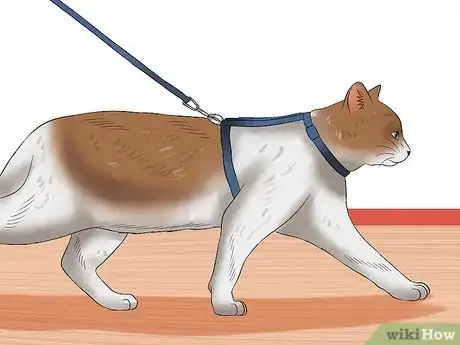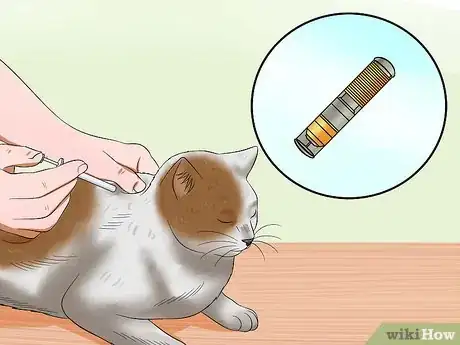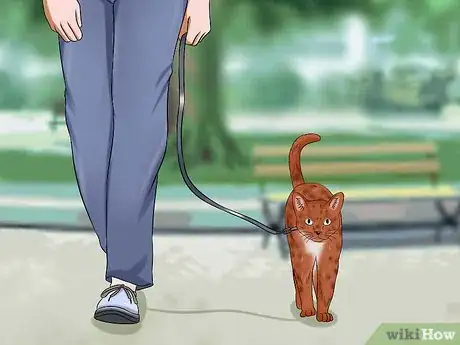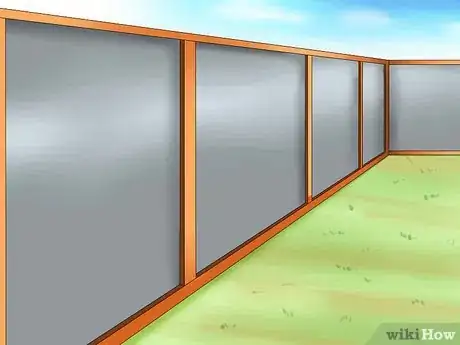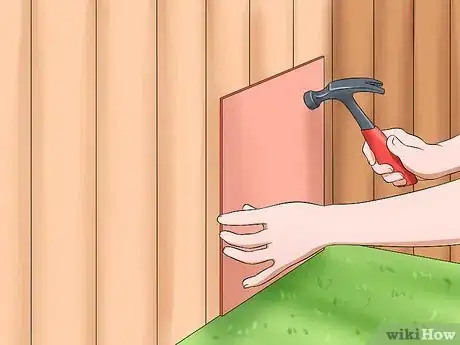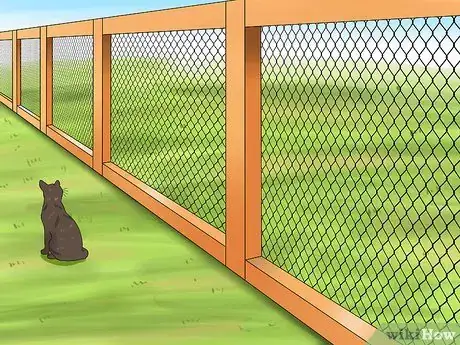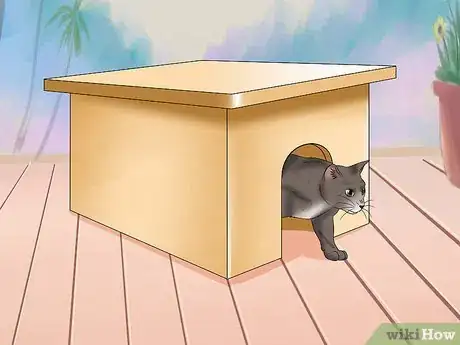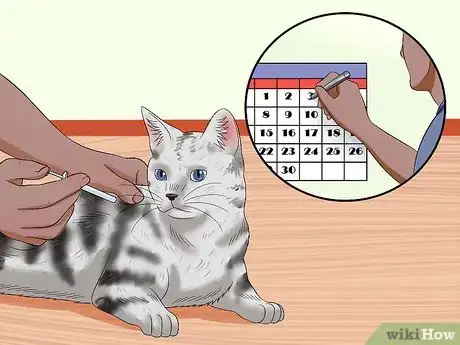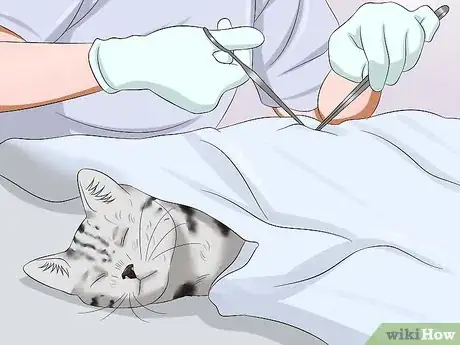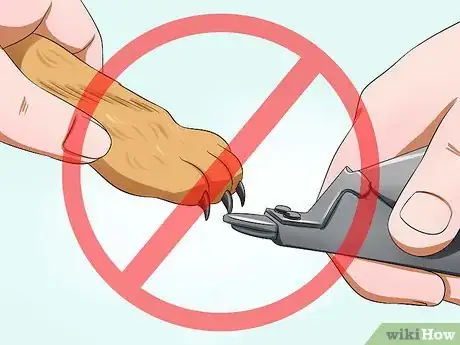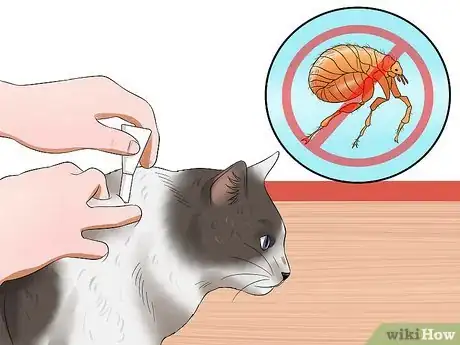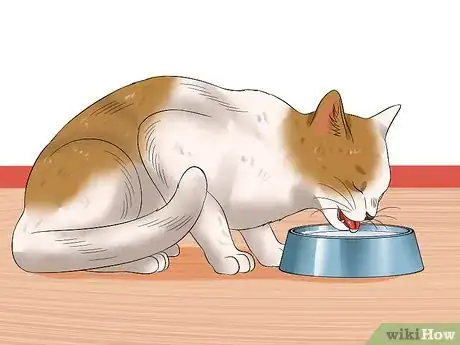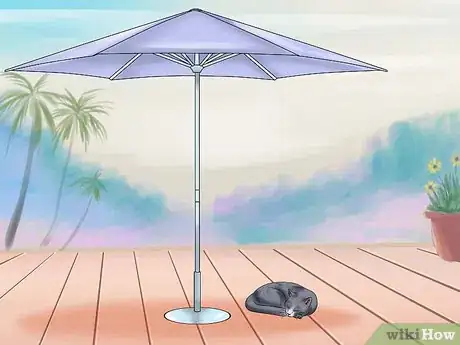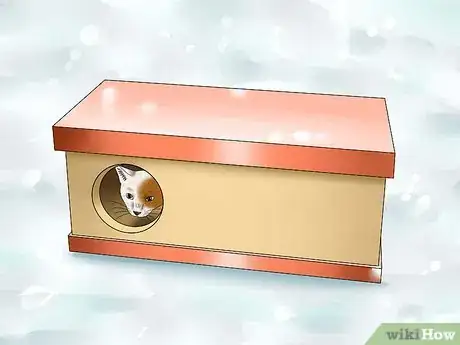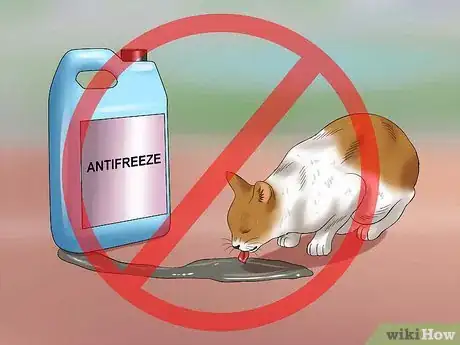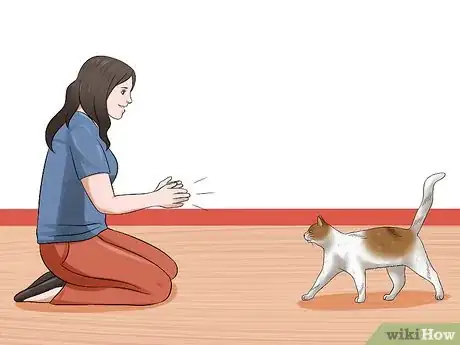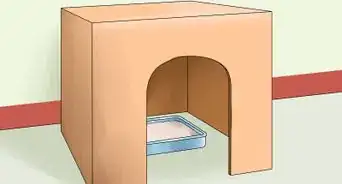This article was co-authored by Pippa Elliott, MRCVS. Dr. Elliott, BVMS, MRCVS is a veterinarian with over 30 years of experience in veterinary surgery and companion animal practice. She graduated from the University of Glasgow in 1987 with a degree in veterinary medicine and surgery. She has worked at the same animal clinic in her hometown for over 20 years.
There are 14 references cited in this article, which can be found at the bottom of the page.
This article has been viewed 26,621 times.
A cat that goes outdoors is exposed to many more dangers than a strictly indoor cat. Because of that, many outdoor cats live much shorter lives than indoor cats. Nonetheless, you can take some steps to protect you cat while outdoors to give him or her a safer environment.
Steps
Keeping Track of Your Cat
-
1Put on a collar with identification. One of the first steps you should take with a cat who's going outdoors is to make sure the cat has a collar with an ID tag. The ID tag should have information such as the cat's name and your phone number. You should also consider a second tag with information that shows your cat is up to date on vaccinations, provided by your vet.[1]
- Breakaway collars are best because they keep your cat from getting hung up on things, which could strangle them. However, cats are more likely to lose this type of collar since they do breakaway.
-
2Consider a harness instead. Another option is a harness, which is a two-part collar. One part goes around the cat's neck and the other part goes under its arms. All of them have a piece that attaches the two circles together along the back and most have a piece that goes along the chest, as well, to keep the collar from choking the cat. If you choose this option, make sure it has a piece that goes along the chest, too.[2]
- Cats are less likely to strangle themselves with this type of collar, but they can still get snagged by things in the yard. You can find harnesses at your local pet store.
- Start by acclimating the cat to the harness. Have treats on hand so the cat associates the harness with good things (food!). Put it on for few minutes several times a day until the cat stops paying attention to it, then put it on when the cat goes outside.[3]
Advertisement -
3Think about microchipping your cat. Another good option in addition to a collar or harness is microchipping your pet. Microchips are small (think rice-sized) chips that are implanted under your cat's skin by your vet. These chips provide your information when scanned, though you must keep it up to date online. When pets are picked up off the streets, most shelters and vets will check for a microchip so your pet can be returned to you.[4]
-
4Consider leash training. Another option to keep your cat from running away to danger is walking them on a leash. Just like dogs, some cats can be walked on a leash with the help of a harness. Starting when the cat is a kitten will make the process easier, though you can still try it with an adult cat.[5]
- Harnesses are much harder for cats to get out of than regular collars, making them more appropriate for walking.
- Once a cat is acclimated to a harness, add a leash. Let the leash drag behind the cat around the house, being sure to stay with the cat in case the leash gets caught. Next, pick up the leash and follow the cat around.
- Finally, start tugging a little to help guide the cat. When your cat gets used to it, you can start going outside with the cat for short periods. Always be on the lookout for dangers to your cat when you're outside, such as dogs and cars. Also, try not to get too close to something your cat can climb, such as tree trunks, as you may find yourself holding the end of a leash with your cat up in a tree.
-
5Put up a metal fence. Another option is to take steps to keep your cat in the yard. Having a metal fence made of planks like a wood fence is a way to keep your cat from climbing up and over it. Your cat can't dig their claws into it, so they can't climb over it.
- Of course, that means it has to be tall enough so your cat can't simply leap to the top and over the fence.
- Also, a chain link fence won't work, as your cat can hook their claws or paws over it to climb up the fence.
-
6Block other ways your cat can escape the yard. If a tree is too close to a fence, your cat may be able to use it to climb up and over. Look for any place in the yard that has things near the fence that a cat could use to get over the fence, including chairs and trellises. Also, check for any places a cat could squeeze through, as they can get through smaller openings than you'd think.
- To keep your cat from escaping, you might need to move things around in the yard so they aren't close enough to the fence to allow escape. In addition, you may need to cut branches or even trees if they are too close to the fence.
- Try to block any escape routes near the ground with boards.
-
7Try a screened-in or blocked-in area. Another option is creating an area where your cats can enjoy the outside air but not be able to leave. A screened-in porch or even a small screened-in area just for your cats is a perfect way to give your cats a taste of the outside while still protecting them from danger.[6]
- Ordinary window screening is susceptible to be scratched apart by your cat.
- Instead, consider chicken wire, chain link, or even wire mesh hardware cloth. All of these can be used to create an enclosure when they are nailed around a wooden frame. Remember that you will need a roof to keep your cat inside this enclosure.
- In addition, you can build a cat door or tunnel that leads out to these areas. That way, your cat can go outside when he or she wants.[7]
-
8Use a pre-built cage. Another option is a cage or kennel you can buy from a store. These cages are made to keep dogs and cats inside them, so you don't have to worry about strength. Additionally, some come with options for adding slings your cat can lay in. You just pop your cat inside and carry the cage outside.[8]
-
9Provide supervision. Another option is staying outside with your cat while he or she is out there. While you may not be able to keep the cat from escaping, you can shoo away any other cats or dangers that might enter the yard.[9]
Keeping Your Cat Healthy
-
1Stay up on vaccinations. When cats go outside, they're exposed to many more diseases than they are when they stay inside. These diseases can be carried by other cats, for instance, or insects that come in contact with your cat. Keeping your cat up on vaccinations helps prevent them from catching these diseases.[10]
- Even if your cat never comes in contact with another cat, diseases can be left in places like soil, meaning your cat can still catch them.
- At the least, your cat should be vaccinated against core diseases once a year. Some vets only recommend every 3 years unless your cat is at a high risk, which outdoor cats are. The core vaccinations are for rabies, feline calicivirus, feline panleukopenia (distemper), and feline viral rhinotracheitis.[11]
- Make sure your vet knows your cat is an outdoor cat, so she or he can recommend the appropriate vaccinations and schedule.
- While your cat is at the vet, it's good to get a checkup, too, as outdoor cats are more likely to run into trouble, including getting into fights, catching parasites and pests, and catching diseases. While you're trying to protect against these problems, your cat may still catch something.[12]
-
2Spay or neuter your cat. If your cat isn't spayed or neutered, he or she is much more likely to come in contact with other cats in search of mating. Contact with other cats is what can lead to diseases as well as scratches from fights. In addition, you won't end up with kittens if you have a female cat.[13]
- A male cat who isn't neutered will be much more likely to try to escape the yard, as well as wander much farther than a neutered male.[14]
- It's best to spay or neuter your cats when they are young, between 2 months and 5 months. Experts advise doing so before 5 months because it gives male cats less of a chance to start spraying (all over your house) and less of a chance your female cat will get pregnant.
- It's a good idea to spay or neuter your cat anyway, as doing so reduces the risk of them developing cancer and several other problems later in life.[15]
-
3Don't declaw. If you plan to let your cats out in your yard, they need to be able to defend themselves. Therefore, you need to let your cats keep their claws instead of getting them declawed. Also, claws let the cat climb away from other predators.[16]
-
4Dose the cat regularly to prevent parasites. An outdoor cat is more likely to pick up fleas and ticks. In addition, heartworms are also a concern. Therefore, it's important to make sure that you give them their medication on time once a month. Usually, that is a a pill for fleas and ticks and a pill for heartworms.[17]
- If you have trouble remembering, set a reminder on your phone.
- Your vet can provide you with the appropriate medications.
-
5Consider pet insurance. Pet insurance is relatively affordable, and it can help you pay for any medical bills that may crop up due to your cat being outside. It works much like human health insurance, where you pay so much per month depending on the coverage you want. You can get anything from catastrophic plans to plans that cover most of the bills and medications.[20]
Providing the Cat with Necessities and Removing Dangers
-
1Provide water. When your cat is outside, make sure to provide access to plenty of fresh water. Though your cat may find other sources, providing clean water ensures your cat will stay hydrated even in hot weather.[19]
- In the winter, consider using a thick plastic bowl or even a solar heated bowl to keep the water from freezing.
- It's best to keep water underneath an overhead cover if possible, to help keep contaminants out of it.
-
2Make sure the cat has shade. Believe it or not, cats can get sunburned, particularly light-colored cats. In addition, cats can overheat. Providing access to shade outdoors helps keep your cat safe from the sun.[20]
-
3Create a winter shelter. If you take care of a strictly outdoor neighborhood cat, providing shelter in the winter can help keep them alive. Basically, the shelter should be be built to trap the cat's body heat, helping them stay alive through cold winter nights and days.[21]
- Keep it small. If it's too big, it will allow too much air and heat to escape, and it will be less effective. One easy solution is a storage container with a lid (35 gallon). You can also build small shelters out of wood.
- You can cut a hole in the side for the cat to enter. The opening you cut should be about 6-by-6 inches and it should be a few inches from the ground. You may also want to cut one on each side. You may need a rock to hold down the shelter, especially in windy weather.
- You also need to insulate the shelter. If you can check on the shelter regularly, straw or pillowcases loosely packed with shredded newspaper or packing peanuts are a good option, as they cat can sink down into it, basically making a nest. However, these types of insulation need to be replaced when they get wet or gross. Another option is adding Mylar to the shelter's walls, floor, and ceiling, which doesn't need to be replaced. Mylar is best where it's really cold. Mylar is a thin plastic sheet that is used to reflect light, but it can also reflect back heat to the outdoor cat.[22] You can staple, tape, or glue the sheet along the walls.
- While it's tempting to use things like blankets, towels, and stacks of newspaper, that's not a good idea, as it absorbs heat rather than reflects it back towards the cat.
-
4Check your yard for dangers. In addition to providing necessities, you need to make sure you don't have dangers in your yard that your cat could get into. For instance, any chemicals could be dangerous for your cat.[25]
- Remove chemicals from the area your cat will be in or lock them up.
- Also consider the plants in your yard. Many plants are toxic to animals, and your cat could eat part of one and become sick. Look up the plants in your yard to see if they could be toxic to your cat.
-
5Bring the cat in during busy times. It's a good idea to only let your cat out when the roads nearby aren't as busy. This step is especially important if you don't want to keep your cat just in your yard. By letting the cat out at low-traffic times, you reduce the risk of the cat being hit by a car.[24]
- Encourage the cat to come back when things get busy.
- One way you can encourage your cat to come in is to have regular meal times around the time that things get busy. Cats usually have a good sense of when dinner is, but you can also make a habit of standing outside and calling the cat home for food ("Spot! Food time!"), which the cat will come to associate with the food.[25]
References
- ↑ http://www.drsfostersmith.com/pic/article.cfm?aid=331
- ↑ http://www.drsfostersmith.com/pic/article.cfm?aid=331
- ↑ http://pets.webmd.com/cats/safe-outdoor-environments-cats
- ↑ http://www.humanesociety.org/animals/resources/tips/microchips.html
- ↑ http://pets.webmd.com/cats/safe-outdoor-environments-cats
- ↑ http://pets.webmd.com/cats/safe-outdoor-environments-cats
- ↑ http://www.drsfostersmith.com/pic/article.cfm?aid=331
- ↑ http://www.drsfostersmith.com/pic/article.cfm?aid=331
- ↑ http://www.americanhumane.org/animals/adoption-pet-care/caring-for-your-pet/indoor-cats-vs-outdoor-cats.html
- ↑ http://pets.webmd.com/cats/safe-outdoor-environments-cats
- ↑ http://www.peteducation.com/article.cfm?c=1+2143&aid=951
- ↑ http://www.safebee.com/family/how-keep-outdoor-cat-safe
- ↑ http://www.drsfostersmith.com/pic/article.cfm?aid=331
- ↑ http://icatcare.org/advice/keeping-your-cat-safe/minimising-risks-outdoor-cat
- ↑ http://www.aspca.org/pet-care/general-pet-care/spayneuter-your-pet
- ↑ http://www.safebee.com/family/how-keep-outdoor-cat-safe
- ↑ http://www.safebee.com/family/how-keep-outdoor-cat-safe
- ↑ www.cats.org.uk/documents/cat-care-leaflets-2013-eg05keepingyourcatsafe
- ↑ http://pets.webmd.com/cats/safe-outdoor-environments-cats?page=2
- ↑ http://pets.webmd.com/cats/safe-outdoor-environments-cats?page=2
- ↑ http://www.humanesociety.org/issues/feral_cats/tips/caring_feral_cats_winter.html
- ↑ https://www.grafixplastics.com/grafix-plastics/plastic-film-plastic-sheet-faq/mylar_what/
- ↑ www.cats.org.uk/documents/cat-care-leaflets-2013-eg05keepingyourcatsafe
- ↑ http://icatcare.org/advice/keeping-your-cat-safe/minimising-risks-outdoor-cat
- ↑ http://icatcare.org/advice/keeping-your-cat-safe/minimising-risks-outdoor-cat
About This Article
To keep your cat safe outside, make sure you put out fresh water daily so it doesn’t get dehydrated. You should also give your cat access to shade, since it’s easy for cats to get sunburnt and overheat. Because outdoor cats are more likely to pick up fleas and ticks, try giving it a monthly medication to prevent this. It’s also a good idea to spay or neuter your cat so it doesn’t mate with another cat while it’s outside. If your cat is going to spend a lot of time outside, consider getting it microchipped, which allows shelters to access your information if it gets lost. To learn how to safely take your indoor cat out on walks, read more from our Veterinary co-author!

